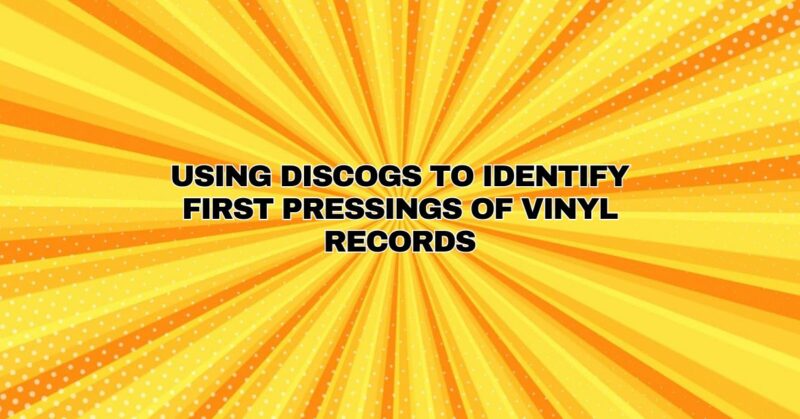Vinyl records have experienced a remarkable resurgence in popularity, attracting both seasoned collectors and newcomers to the world of analog music. For collectors, one of the most exciting pursuits is identifying first pressings of their favorite albums. These early editions often come with historical significance and potential sonic advantages. Discogs, a comprehensive online music database and marketplace, has become an invaluable tool for vinyl enthusiasts seeking to identify first pressings. In this guide, we’ll explore how to effectively use Discogs to uncover the treasure of first pressings.
What Is Discogs?
Discogs is a user-contributed online music database and marketplace that catalogs and connects music enthusiasts worldwide. It hosts a vast collection of data on vinyl records, CDs, cassettes, and other physical music formats. Users can search for specific releases, artists, and labels, and contribute information about their collections, including details about pressings, condition, and release variations.
Why Discogs for Identifying First Pressings?
Discogs has become a go-to resource for identifying first pressings due to several key features:
- Extensive Database: Discogs boasts an extensive and continuously growing database of music releases, including vinyl records. This database is enriched by contributions from users worldwide, making it a valuable repository of music knowledge.
- Release History: Each entry on Discogs provides a detailed release history of a specific album or single. This history includes information about different pressings, label variations, and reissues, helping collectors identify first pressings.
- Catalog Numbers: Discogs includes catalog numbers for each release, which are crucial for identifying unique editions. A change in catalog number often signifies a different pressing.
- Label Information: Users can contribute images and information about labels, including details about label designs and variations. This is essential for identifying early pressings, as labels often change over time.
- User Contributions: The community-driven nature of Discogs allows collectors to share their knowledge and expertise. Users often contribute photos, descriptions, and comments that provide valuable insights into specific pressings.
How to Use Discogs to Identify First Pressings:
- Create an Account:
- To get started with Discogs, create a free account. An account allows you to contribute to the database, add items to your collection, and communicate with other users.
- Search for Your Vinyl Record:
- Use the search bar to find the vinyl record you want to identify. Enter the artist, album title, and any other relevant details.
- Explore the Release Page:
- Once you’ve found the release you’re interested in, click on it to explore the release page. This page contains a wealth of information.
- Examine the Release History:
- Scroll down to the “Versions” section of the release page. Here, you’ll find a comprehensive list of all known versions of the release, including different pressings and editions.
- Identify First Pressings:
- Look for details that distinguish first pressings from later editions. These may include unique catalog numbers, label variations, and specific release notes.
- Review Images and Descriptions:
- Many release pages on Discogs include images and descriptions contributed by users. Examine these to get a visual sense of the release and to compare it with your copy.
- Contribute Information:
- If you have valuable information about your vinyl record that is not yet included on Discogs, consider contributing. This helps enrich the database for the benefit of other collectors.
- Join the Community:
- Engage with the Discogs community by joining forums and discussions related to vinyl collecting. You can seek advice, share your knowledge, and connect with fellow enthusiasts.
- Check Marketplace Listings:
- If you’re interested in buying or selling a vinyl record, Discogs also functions as a marketplace. You can browse listings to see how similar releases are priced and sold.
Tips for Accurate Identification:
- Be Thorough: Pay attention to all available details on the release page, including matrix numbers, label information, and release notes. The more information you have, the more accurate your identification will be.
- Compare with Your Copy: Compare your vinyl record with the images and descriptions on Discogs. Look for any distinguishing features or differences that match a first pressing.
- Use External Resources: In addition to Discogs, consult other vinyl collecting resources, such as collector forums, books, and expert opinions, to cross-reference and verify your findings.
- Ask for Help: Don’t hesitate to ask for help from the Discogs community or vinyl collecting forums if you’re unsure about a particular pressing. Experienced collectors are often willing to share their knowledge.
Conclusion: Discovering Vinyl’s Rich History
Using Discogs to identify first pressings of vinyl records is a rewarding and educational journey for collectors and music enthusiasts. The platform’s extensive database, user-contributed knowledge, and detailed release histories empower collectors to uncover the rich history behind their vinyl treasures. Remember that the pursuit of first pressings is not just about rarity; it’s about preserving the historical context and appreciating the craftsmanship and sound quality of these early editions. Happy hunting, and may your vinyl collection continue to grow and amaze!

